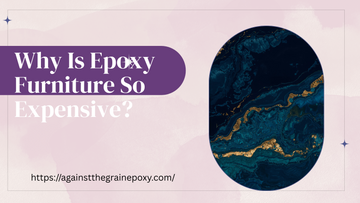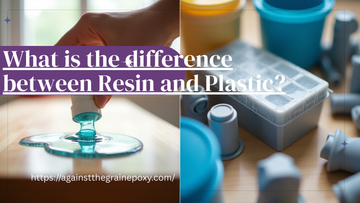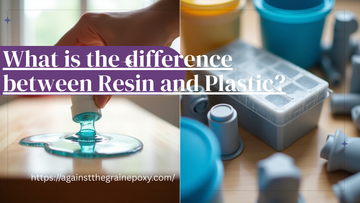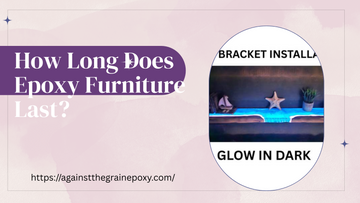Epoxy furniture has become a standout in modern interior design, known for its flowing river patterns, polished finishes, and unique craftsmanship. Each piece feels more like a work of art than just furniture.
However, many people are surprised by the cost and wonder what justifies the investment.
In this article, we’ll explore the factors behind the higher price point, the detailed process involved in making epoxy furniture, and whether it’s a meaningful and lasting addition to your living space.
What Is Epoxy and Epoxy Furniture?
Epoxy resin is a durable, clear or tinted material used in a wide range of applications, from industrial flooring to fine art. In furniture making, it’s combined with hardwood, often live-edge slabs, to create showstopping pieces that blend function with artistic beauty.
You may have seen epoxy resin tables, river tables, where colored resin flows like a stream between two slabs of wood. These are perfect examples of resin furniture, functional pieces that double as statement art.
Quick Specs: Common Epoxy Furniture Features
-
Materials: Hardwood (butternut, acacia, maple, and spalted birch) + epoxy resin
-
Size Range: From 2-ft side tables to 10-ft dining tables
-
Weight: 80–400+ lbs, depending on size and materials
-
Customization: Logos, metallic inlays, LED glows
-
Popular Forms: River tables, resin wood tables, desks
Why Is Epoxy Furniture So Expensive?
The beauty isn’t the only thing that’s layered. The high cost of epoxy furniture comes from premium materials, intensive labor, and complex production methods. Let’s break down the core reasons.
1. Premium Materials Used
These pieces start with good quality hardwoods like walnut, oak, maple, or exotic woods such as monkeypod. These aren’t standard planks; they’re often kiln-dried, sustainably sourced, and live-edge for a natural, organic look.
To that, add high-grade epoxy resin—designed for strength, clarity, and UV resistance, plus pigments, glow powders, and metallics..
Premium Wood and Resin Materials
-
Walnut slabs: $200–$2,000+ depending on size and grain
-
Epoxy resin: $50–$150 per gallon (high-end types can exceed this)
-
Pigments & glow: $10–$60 per project
-
Molds & finishes: $100–$500 for custom molds and surface finishing
For a large table, 5–10+ gallons of resin may be needed, bringing resin material cost alone to $500–$1,500+.
2. Custom Craftsmanship and Handmade Quality
Each piece of epoxy wood furniture is handcrafted, not factory-produced. There are no shortcuts. Skilled artisans dedicate dozens of hours to every phase, from wood prep and resin pouring to sanding and finishing.
Errors can come at a cost, and perfection is expected. You’re not just paying for furniture, you’re investing in the artisan’s time, talent, and experience.
Labor Costs in Epoxy Furniture
-
Time spent: 30–120+ hours per piece
-
Skill required: High; includes woodworking, resin work, and finishing
-
Error tolerance: Extremely low; one mistake could ruin the piece
3. Complex Resin Table Manufacturing Process
The production process is detailed. Here’s a typical flow:
Step-by-Step Process:
-
Drying the wood: Kiln-dried to prevent warping and moisture issues
-
Building the mold: Custom mold created to fit the design
-
Sealing & pouring: Resin applied in multiple layers for depth and clarity
-
Curing: Resin takes 3–7 days to harden fully
-
Demolding & sanding: Hand-sanded across multiple grits
-
Polishing & finishing: Final finish options include gloss, matte, or oil
Even shipping is a challenge; these pieces are heavy, fragile, and often require custom crates.
Factors Affecting Resin Furniture Price
Prices vary from piece to piece. A small side table might be under $1,000, while a large live-edge epoxy table can run over $7,000 or more.
Key Pricing Factors:
-
Size: Larger builds require more materials and labor
-
Design complexity: River shapes, embedded items, glow effects
-
Finish type: Glossy finishes involve more sanding and polishing
-
Customization: Names, logos, metallics, or LED lighting
-
Labor costs: Vary depending on location and artisan skill
Epoxy vs Regular Furniture: Is It Worth It?
Is epoxy worth more than traditional wooden or store-bought furniture?
Advantages of Epoxy Resin Furniture
-
Durability: Water-resistant, heat-tolerant, and long-lasting
-
One-of-a-kind design: No two tables are exactly alike
-
Personalization: Add colors, themes, or names
-
Visual impact: Functional art and conversation Starte
Mass-produced furniture may be more affordable; however, it lacks the craftsmanship and uniqueness of epoxy wood furniture.
Why Are Resin Tables Expensive?
Prices for river tables often range between $2,000–$7,000, with complex builds exceeding $10,000. On average, artisans charge $700–$1,000 per linear foot, so a 6-foot dining table could cost $4,200–$6,000+.
Cost Breakdown: Epoxy Resin Table
-
Epoxy resin (5–10 gallons): $500–$1,500
-
Premium wood slab: $500–$3,000
-
Labor: $1,500–$4,000
-
Custom finishes/add-ons: $200–$800
-
Total estimate: $3,000–$10,000+
The Long-Term Value of Epoxy Furniture
So, is epoxy furniture worth the investment? Yes, if you value quality and originality.
Here’s Why:
-
Longevity: With care, epoxy furniture lasts 20–30+ years
-
Eco-consciousness: Many makers use reclaimed or sustainable wood
-
Uniqueness: No two pieces are ever the same
-
Resale/art value: Some custom builds can appreciate over time
Conclusion
A well-crafted piece of furniture does more than fill a room; it tells a story. These ocean-inspired resin designs bring warmth, motion, and a sense of calm into any space. With rich wood textures and flowing resin that mimics the sea, each creation offers both beauty and purpose.
Looking to bring that kind of timeless character into your home?
Discover handcrafted pieces that speak to your style—shop from Against the Grain Epoxy.
FAQ (Frequently Asked Questions)
Q: How to clean outdoor resin furniture?
A: Wipe with mild soap, warm water, and a soft cloth. For mildew, use a vinegar-water mix. Avoid harsh scrubbers. Rinse and dry to prevent spots.
Q: Why do epoxy tables cost so much?
A: Made with fine hardwood and resin, each piece is handcrafted with care, skill, and detail, turning furniture into functional art.
Q: How long does epoxy furniture last?
A: With proper care, it can last 20 to 30 years or more. The moisture-resistant surface helps prevent warping, rotting, and damage over time.
Q: Are epoxy tables prone to scratching?
A: Epoxy surfaces are scratch-resistant, but not completely immune. With heavy use or sharp items, minor marks can form. Use placemats and clean gently to keep the finish looking its best.






